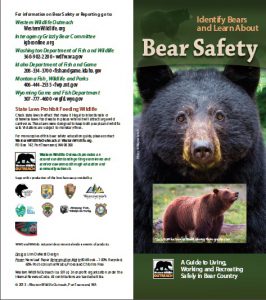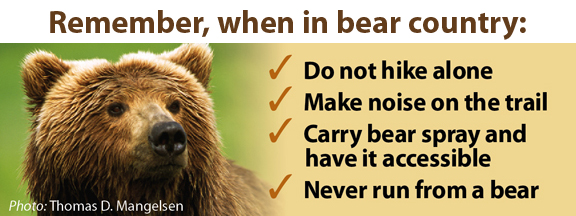[toc class=”toc-right”]
Staying Safe in Bear Country
Bear attacks are very rare though many thousands of people live, work and recreate in bear country. Bears are far more likely to enhance your wilderness experience than spoil it.
Visit our Tips for Coexistence page to learn about preventing human conflicts; remember that it is always good to be prepared for an encounter. You should always carry bear spray while recreating in bear country and know how to use it. Watch this excellent video by our partners at Counter Assault.
https://youtu.be/pc0_GqXKETA
Remember, there is no fool-proof way of dealing with a bear encounter: each bear and encounter is different. Knowing how to interpret their behavior and how to act responsibly is part of the pleasure of sharing our environment with wild bears.
Bear Body Language
Bears may appear tolerant of people and then attack without warning. A bear’s body language can help you determine its mood. A bear may stand on its hind legs or approach to get a better view, but these actions are not necessarily signs of aggression: the bear may not have identified you as a person and may be unable to smell or hear you from a distance. In general, bears show agitation by swaying their heads, huffing, popping their jaws, blowing and snorting, or clacking their teeth. Lowered head and laid-back ears also indicate aggression.
Predatory vs. Defensive Bear Attacks
If you see a bear in the distance, respect the bear’s need for space. Try to make a wide detour or leave the area. If you suddenly surprise a bear at close range, STOP. Don’t crowd the bear – leave it a clear escape route and it will probably exit. Assess the situation: is the bear acting in a calm and curious manner, or is it acting in a predatory or defensive manner?
Defensive Confrontations:
Defensive confrontations are usually the result of a sudden encounter with a bear protecting its space or food cache, and with female bears with young. Defensive confrontations seldom lead to contact. In defensive confrontations, the bear is threatening you because it feels threatened.
If you suddenly surprise a bear, remain calm and do not run.
- Speak in a low monotone voice so the bear can identify you as human.
- A bear may charge in an attempt to intimidate you – usually stopping well short of contact.
- If a bear begins to charge, use Bear Spray as instructed under the Bear Spray section of this brochure.
- If Bear Spray does not deter a Defensive Confrontation, drop to the ground and play dead to allow the spray to take effect. Protect your back by keeping your pack on. Lie on your stomach, clasp your hands behind your neck, and use your elbows and toes to avoid being rolled over. If the bear does roll you over, keep rolling until you land back on your stomach.
- Remain still and quiet. A defensive bear will stop attacking once it feels the threat has been removed.
- Do not move until you are absolutely sure the bear has left the area.
Predatory Confrontations:
Predatory attacks by bears are very rare, but do occur. Any bear that continues to approach, follow, disappear and reappear or displays other stalking behaviors is possibly considering you as prey. Bears that attack you in your tent or confront you aggressively in your campsite or cooking area should also be considered a predatory threat.
- If the bear does not respond to aggressive actions such as yelling, throwing rocks and sticks, etc., you should be prepared to physically fight back if it attempts to make contact.
- Try to be intimidating: look as large as possible.
- If you have bear spray, emit a deterring blast, preferably before the bear is within twenty-five feet. This gives the animal time to divert its advance.
- If the bear continue to follow, place your pack or other items down as a distraction.
- If a grizzly bear following you, climbing a tree may be an option but it is no guarantee of safety.
From Center for Wildlife Information.
Additional Resources for Staying Safe in Bear Country
- Learn more about Bear Spray versus Bullets research results
- For additional information about properly avoiding unwanted bear encounters, read Dr. Stephen Herero’s “Bear Attacks: Their Causes and Avoidance,” and listen to the interview with Dr. Herero posted on The Bear Smart Society website.
- To learn more about staying safe and living in grizzly bear country, consider ordering the following videos provided by the Safety in Bear Country Society (SIBCS). SIBCS is made up of a number of world-renowned bear experts who have worked in collaboration with the International Association for Bear Research and Management (IBA)to create a series of videos about safety in bear country. All three videos can be ordered through Distribution Access, information below.
Reporting
If you have seen a grizzly bear
There are several options if you think you have seen a grizzly bear, but quick reporting is critical – please use whichever option is most convenient. If possible, please contact each of the organizations below.
- Call the wolf-bear hotline: 1-888-WOLF-BEAR (US Fish and Wildlife Service, Olympia)
- WA or ID Patrol or Ranger Stations (see links below)
Please be as specific as possible in your message about the location and time of the observation.
- What exactly did you see (e.g. a single bear, family group, a grizzly bear plant dig, a carcass)?
- Let us know if you took photographs or measurements.
- What made you think that it was a grizzly bear or grizzly bear field sign?
- Remember to give your full name and telephone number.
If you need to report an incident
Report all observations and field sign to your local Washington State Patrol Office, Idaho State Patrol Office, the nearest Washington ranger station or Idaho ranger station.
In case of an emergency, call 911
Visit the Products page to see our Bear Safety brochure.


